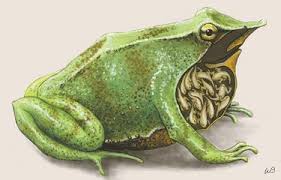the frog reproductive system
THE Australian gastric brooding frog, thought to be extinct since 2002, had a bizarre means of reproduction. The female swallowed her fertilized eggs and incubated her young in her stomach for about six weeks. Her babies later emerged from her mouth as fully developed frogs.
To keep from digesting her eggs, it was necessary that the mother frog not only stop eating but also stop producing stomach acid. Evidently, chemicals released by the eggs and hatchlings inhibited the production of acid.
The mother would brood about two dozen eggs. By the time she gave birth, her young could make up almost 40 percent of her total body weight. This would be like a woman who weighed 150 pounds (68 kg) before she became pregnant carrying 24 babies weighing four pounds (1.8 kg) each! The young frogs stretched the mother’s stomach to the point that it completely compressed her lungs, forcing her to breathe through her skin.
The baby frogs would normally emerge over a period of days as they became ready. If the mother sensed danger, though, she would give birth by vomiting them out. Researchers once observed a female expel six young frogs together, shooting them about 40 inches (1 m) in the air.
If, as some claim, its reproductive system evolved, the gastric brooding frog would have had to make vast changes to both its physical makeup and its behavior all at once. “It is inconceivable to contemplate a slow and progressive change in its reproductive biology,” wrote scientist and evolutionist Michael J. Tyler. “The habit is totally effective or it fails completely.” The only plausible explanation, Tyler says, is “a single, huge, quantum step.” Some would say that such a quantum step is called creation.
0 comments